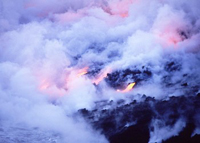


|
 |
|
In nature, destructive forces like fires, landslides, volcanic eruptions, tornadoes, and even strong winds can cause the landscape to change in the blink of an eye. As we head toward the ocean, we'll go through some mudslide areas that are about a year old. You'll be able to see some of the "healing" or re-growth that's happening in those areas. Change in EcosystemsEcosystems are always undergoing changes. Ecologists call the natural progression of changes from one type of ecosystem to another succession. There are two basic types of succession.
Primary Succession
 Primary succession takes place on newly formed surfaces, like when a volcano erupts and lays down new rock, or when a glacier melts, leaving a newly exposed surface. These newly formed surfaces are slowly colonized by plants and animals.
Primary succession takes place on newly formed surfaces, like when a volcano erupts and lays down new rock, or when a glacier melts, leaving a newly exposed surface. These newly formed surfaces are slowly colonized by plants and animals.
Primary succession begins soon after the brand new rock is formed. Water eventually pools in the cracks of the rocks. The rock weathers and soil begins to form and plant life can begin to take root. Over time, the plants get larger and animals begin to inhabit the area. After many, many years a stable community is formed. A community with little or no change is called a climax community. Surtsey Island: Primary Succession in ActionIn 1963, an underwater volcanic eruption began off the southern coast of Iceland. During the next four years the volcano was active and as a result of the eruptions, the island of Surtsey was formed. At the time, Surtsey was considered the "newest place on earth." It was a barren rock island, a literal laboratory that was perfect for observing the process of primary succession. Scientists were just brimming with questions like:
Do you see how rich an opportunity observing this new island would be?
Secondary Succession
Yellowstone National Park: The Fires of 1988In 1988 at Yellowstone National Park, forest fires burned out of control for about two months. Thousands of acres of land were burned. August 20, 1988, proved to be the worst day during these fires. High winds pushed the fire across more than 150,000 acres of the park. In the end about 36 percent of the park's acres were scorched. Since the fires, scientists have been watching the re-growth of this area, an example of secondary succession, progress over the past 18 years. During this time they have observed many new species of wildflowers, grasses and ferns grow. They have seen pine seedlings that will eventually grow and mature into forest again. The area has not reached its climax community yet, but in time it will develop a stable community of many plants and animals and will probably be very similar to the old forest community that was there before the fires. One of the unique things about the plants and animals that inhabit Yellowstone is that they have special adaptations that are actually benefited by fire. The majority of the forested area in Yellowstone is Lodgepole Pine. These trees actually require fire for their cones to open and release the seeds. When an ecosystem is healthy, there is a wide variety of organisms that live there. Ecologists call this biodiversity, which we'll talk about soon. Check out the new life after the fire. What changes have occurred?
Ecologists study both the slow and the fast changes that occur in ecosystems to get a better understanding of what relationships exist in an environment. They can then use this information to predict what might happen if an ecosystem is disturbed in the future. Click on the Travel Log tab to continue your Extreme Eco Challenge.
Images © clipart.com 2006, landslide © USGS 2006, burn and new growth images © National Park Services 2006
|
|
|
Unless otherwise noted, © 2006 - 2008 FLVS |
|
|